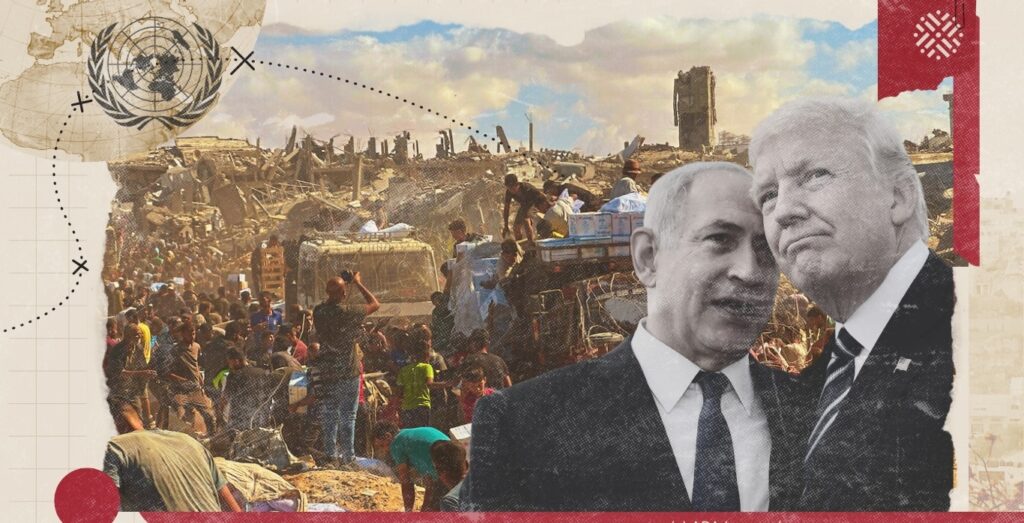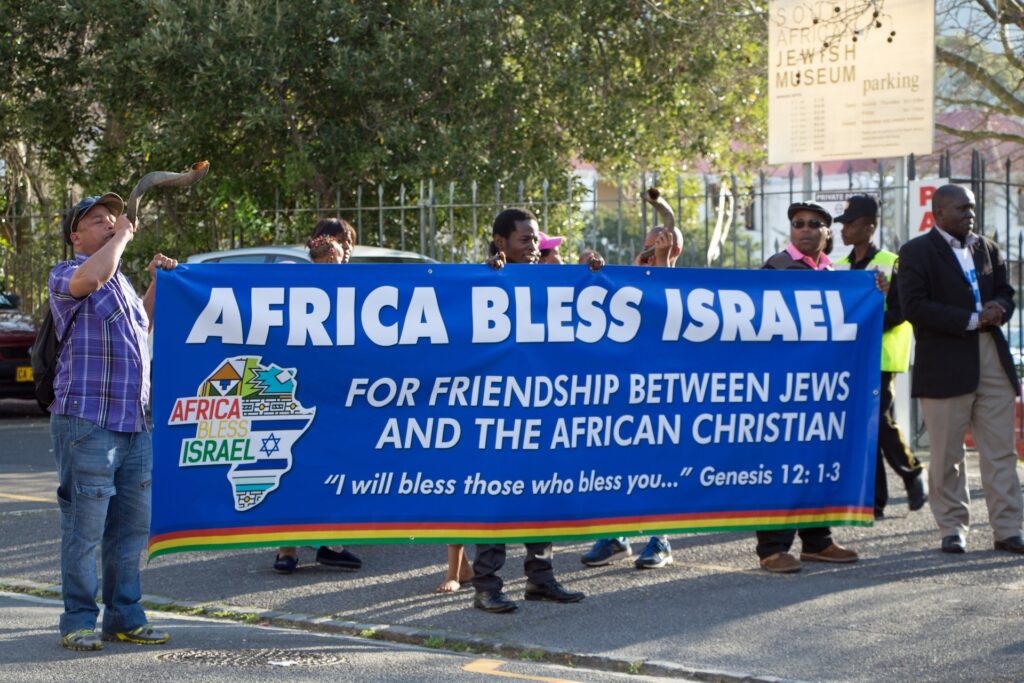- Topics
-
Topics
See our analysis on civil society and how it shapes culture, politics, and policies
Read our insights on the shifting political landscape and what it means for Palestine
Learn more about the policies and practices shaping the Palestinian economy
Strengthen your understanding of the unique conditions for Palestinian refugees across the Middle East
-
- Analysis
-
Analysis
In-depth analysis on existing or potential policies that impact possibilities for Palestinian liberation.
Insights and perspectives on social, political, and economic questions related to Palestine and Palestinians globally.
Concise analysis into a specific policy, its background and implications.
Commentary that brings together insights from multiple analysts.
Compilations of past Al-Shabaka works surrounding a specific theme.
Longer-form, ad hoc projects that seek to confront research questions outside the scope of our regular analysis.
A policy-driven research initiative by Al-Shabaka: The Palestinian Policy Network.
Our monthly webinar series that brings together Palestinian experts.
Featured
The global reckoning that followed October 7, 2023, marked a profound rupture in how Palestine is understood worldwide. The Gaza genocide exposed how Israeli mass violence is not exceptional or reactive, but foundational to the Zionist project. What was once framed as a “conflict” to be managed is now widely recognized as a system of domination to be dismantled. It ushered in a shift away from the technocratic language of peace processes and toward an honest confrontation with the structural realities Palestinians have long named: settler colonialism, apartheid, and the ongoing Nakba. The commentary argues that the Israeli genocidal campaign in Gaza has radicalized the world. When crowds march through global capitals demanding a free Palestine, they simultaneously articulate demands for the abolition of racial capitalism, extractive regimes, climate injustice, and all forms of contemporary fascism. In this moment of radical clarity, Palestine becomes a lens through which the underlying architecture of global domination is laid bare—and through which new horizons of collective freedom emerge. Tareq Baconi· Dec 21, 2025Inès Abdel Razek and Munir Nuseibah joined Al-Shabaka for a conversation on the politics behind the UNSC resolution, the implementability of the US-Israeli plan, and the scenarios now being advanced for Gaza and for Palestine more broadly.
Tareq Baconi· Dec 21, 2025Inès Abdel Razek and Munir Nuseibah joined Al-Shabaka for a conversation on the politics behind the UNSC resolution, the implementability of the US-Israeli plan, and the scenarios now being advanced for Gaza and for Palestine more broadly.
 European empires used Christian missions to legitimize conquest in Africa and advance imperial interests, laying the groundwork for a political form of Christian Zionism. British evangelicals were central in transforming Christian Zionism from a theological belief into an imperial strategy by promoting Jewish resettlement in Palestine as a means of extending British influence. This fusion of religious ideology and imperial ambition endures in contemporary Christian Zionist movements, which frame modern Israel as the fulfillment of biblical prophecy and recast Palestinian presence as an impediment to a divinely ordained order. This policy brief shows how these narratives and their policy effects have taken root in the Global South, including in South Africa. In this context, Israeli efforts increasingly rely on Christian Zionist networks to weaken longstanding solidarity with Palestinians and cultivate support for Israeli occupation.
European empires used Christian missions to legitimize conquest in Africa and advance imperial interests, laying the groundwork for a political form of Christian Zionism. British evangelicals were central in transforming Christian Zionism from a theological belief into an imperial strategy by promoting Jewish resettlement in Palestine as a means of extending British influence. This fusion of religious ideology and imperial ambition endures in contemporary Christian Zionist movements, which frame modern Israel as the fulfillment of biblical prophecy and recast Palestinian presence as an impediment to a divinely ordained order. This policy brief shows how these narratives and their policy effects have taken root in the Global South, including in South Africa. In this context, Israeli efforts increasingly rely on Christian Zionist networks to weaken longstanding solidarity with Palestinians and cultivate support for Israeli occupation. Fathi Nimer· Dec 7, 2025
Fathi Nimer· Dec 7, 2025
-
- Resources
- Media & Outreach
- The Network



Gaza Uninhabitable: Challenging Colonial Frames of Erasure
Introduction
The erasure of Indigenous populations lies at the core of settler-colonial narratives. These narratives aim to deny existing geographies, communities, and histories to justify the displacement and replacement of one people by another. The Zionist project is no exception. Among Zionism’s founding myths is the claim that it “made the desert bloom” and that Tel Aviv, its crown jewel, arose from barren sand dunes—an uninhabitable void transformed by pioneering settlers. This framing obscures the fact that the colonial regime initially built Tel Aviv on the outskirts of Yaffa (Jaffa), a thriving Palestinian city with a rich cultural life and a booming orange trade. The “dunes” description projects emptiness and conceals the vibrant agricultural and social life that flourished in the area. By casting the land as uninhabitable until redeemed by settlers, this narrative helped justify dispossession and colonial expansion. This process intensified after 1948, when Tel Aviv absorbed the lands of ethnically cleansed Palestinian villages, including al-Sumayil, Salame, Shaykh Muwannis, and Abu Kabir, and ultimately extended into the city of Yaffa.
This same settler-colonial discourse drives the ongoing genocidal war on Gaza, where destruction is reframed through the narrative of “uninhabitability.” Gaza is increasingly depicted as a lifeless ruin—a framing that is far from neutral. This commentary contends that “uninhabitable” is a politically charged term that masks culpability, reproduces colonial erasure, and shapes policy and public perception in ways that profoundly affect Palestinian lives and futures. It examines the origins, function, and implications of this discourse within the logic of settler colonialism, calling for a radical shift in language from narratives that obscure violence to those affirming Palestinian presence, history, and sovereignty.
Erasure: From Terra Nullius to “Uninhabitable”
The concept of terra nullius—land cast as empty and ownerless—underpinned the imperial ideology driving British Christian Zionism in the nineteenth century. In 1840, the British navy deployed steamboat warfare on Palestine’s shores for the first time, and within three days the fortified city of Akka, which had once repelled Napoleon, fell to allied forces. Reduced to rubble, the city’s destruction fed a colonial discourse that read physical devastation as evidence of absence, collapsing the line between material ruin and demographic void and legitimizing colonial claims to an allegedly empty land.
'Uninhabitability' obscures the perpetrators and serves colonial narratives, framing Gaza not as deliberately destroyed but as unfit for life—awaiting erasure or replacement Share on XAdopting this British imperialist doctrine, the Zionist movement systematically disregarded the presence, rights, and aspirations of Palestine’s Indigenous population. As Rashid Khalidi documents, this erasure was starkly illustrated in Theodor Herzl’s 1899 response to a letter from the Palestinian scholar Yusuf Diya al-Khalidi, who warned that Palestine’s inhabitants would not accept being displaced from their land. Herzl’s reply dismissed the agency, rootedness, and enduring presence of the Indigenous population, reflecting a core Zionist idea that overlooked or erased Palestinian existence.
In 1917, during World War I, the British bombed yet another Palestinian coastal fortress city, Gaza, leaving it heavily damaged, depopulated, and materially devastated. British shelling destroyed more than a third of the city’s buildings and stripped many others of essential structural elements such as roofs, doors, and windows. After the bombing, the Palestinian inhabitants of Gaza reoccupied the remnants of their homes and sheltered in whatever had survived the destruction. Nonetheless, the British High Commissioner Herbert Samuel officially declared the city uninhabitable. Drawing a parallel with the war-torn landscapes of France and Belgium, Samuel proposed a reconstruction plan and his employer, the British Foreign Office, suggested approaching the Zionist Federation to fund the city’s rebuilding. While this ultimately did not materialize, the very suggestion reflected Britain’s broader strategy of advancing Zionist settlement in Palestine through material entrenchment on the ground. It also reveals the instrumentalization of post-war “humanitarian relief” to serve colonial ambitions, turning Gaza’s recovery into a vehicle for imperial interests. In the end, Gaza’s own Indigenous Palestinian inhabitants gradually rebuilt the city. Following the Nakba in 1948, Gaza became a refuge for Palestinians expelled from other parts of historic Palestine, further entrenching its role as a space of displacement and containment.
Gaza’s Liveability in the 2010s: A UN-Framed Crisis
The concept of uninhabitability in relation to Gaza resurfaced in 2012, when the United Nations Country Team in the Occupied Palestinian Territory warned that the strip would become unliveable by 2020 without urgent and sustained intervention. In 2015, the United Nations Conference on Trade and Development issued a similar warning, projecting that Gaza could become uninhabitable within five years. The aid and development sector subsequently echoed these warnings and framed them as ominous yet seemingly inevitable.
The UN bodies based their warnings on concrete indicators such as collapsed infrastructure, water contamination, overpopulation, and mass unemployment. Though cast as a humanitarian tragedy, this was a crisis carefully manufactured by Israeli policy. Since 2007, Israel’s blockade, widely condemned as collective punishment, has damaged Gaza’s economy and obstructed recovery, while successive military assaults have further destroyed essential infrastructure. Yet this discourse of uninhabitability has depoliticized Gaza’s devastation through the obfuscation of the root cause: Israeli settler colonialism.
Like terra nullius, uninhabitability obscures the perpetrators and serves colonial narratives, framing Gaza not as deliberately destroyed but as inherently unfit for life—awaiting erasure or replacement. In this way, the UN’s projections, however well-intentioned, echo the settler-colonial logic that frames Palestinian dispossession as inevitable rather than imposed.
This discourse also reflects what Edward Said famously described as the colonial making of “imaginative geographies”—an imperial practice that strips communities of agency and humanity in order to legitimize control. Today, this is evident in portrayals of Gaza not as a home, but as a “demolition site”; not as a society, but as a problem to be managed. Such representations erase Palestinian political will and resistance, recasting a people engaged in a longstanding anti-colonial struggle as helpless victims awaiting salvation.
Unliveability by Design: Necropolitics in Gaza
Achille Mbembe’s concept of necropolitics sheds light on how the Israeli regime exercises control over Gaza through the orchestration of unliveability. Necropolitics is about more than deciding who lives and who dies; it is about shaping conditions so that specific populations are forced to live in environments that are unliveable. In necropolitical terms, unliveability is the deliberate production of degrading conditions that slowly erode life, while uninhabitability is the endpoint where survival is no longer possible. Gaza is a stark example of this continuum: it has become what Mbembe calls a “death-world,” where daily life is systematically stripped of the means to survive. This is achieved through Israeli policies that collapse the foundations necessary for life, including the repeated destruction of water networks, hospitals, schools, and homes, alongside the deliberate obstruction of reconstruction. It is precisely within this necropolitical context that the “uninhabitable” framing takes hold.
Palestinian persistence reveals Gaza not as uninhabitable, but as actively re-habitable—remade liveable through the steadfast work of its people Share on XOnce Gaza is cast as unliveable or uninhabitable, attention shifts from the Israeli regime’s responsibility to international humanitarian aid and relief. In addition, this framing creates a self-reinforcing logic: aid preserves life only within the very structures Israel has built to produce death and unliveability. In this way, humanitarian assistance becomes embedded in the very apparatus of necropolitical control, offering only temporary respite while leaving the colonial system intact and its perpetrators exempt from accountability. Today, as the genocide continues to unfold, humanitarian aid has itself become a death trap.
Moreover, the uninhabitability framing encourages donor fatigue, discourages sustained international engagement, and opens the door to proposals for population transfer or forced relocation—often framed as humanitarian solutions. It also undermines Palestinians’ right to remain in Gaza, erodes their broader right to self-determination, and sows despair. Most insidiously, it erases the persistent efforts of Palestinians to rebuild, resist, and assert life in the face of genocidal destruction, recasting them as passive victims rather than political subjects engaged in resistance and survival. This discourse does not simply distort reality; it advances the longstanding colonial project of rendering Palestinian agency invisible.
Pivoting Toward Re-Habitability
To dismantle the settler-colonial logic embedded in the discourse of uninhabitability, we must reframe Gaza conceptually and politically. This begins with holding accountable the structures and actors responsible for its devastation: the Israeli regime and the complicity—or strategic negligence—of international institutions. We must also insist that Gaza is not a space beyond salvation. It is a site of continuous struggle, creativity, and collective endurance. Even amid genocidal violence, Palestinians persist in building homes, cultivating land, educating children, and asserting their right to live with dignity. This Palestinian persistence reveals Gaza not as uninhabitable, but as actively re-habitable—remade liveable through the steadfast work of its people.
The concept of re-habitability offers a critical alternative to narratives of collapse. It foregrounds the everyday practices through which life in Gaza is reclaimed and sustained in the face of structural destruction. Recent initiatives—such as reusing rubble to construct shelters, marking farmland with debris and reviving businesses with salvaged materials—are not merely signs of resilience. They are political acts that resist erasure and confront the passivity embedded in humanitarian discourse. Re-habitability, in this sense, is both a material practice and a discursive intervention: it affirms the possibility of living otherwise, even within systems designed to extinguish life.
History shows that cities rarely remain in ruins forever, and Gaza exemplifies this truth Share on XRe-habitability, then, is not simply about survival; it is a political assertion that challenges the structures designed to render Gaza unliveable. Yet this assertion is continually undermined by the very systems that claim to support Gaza’s recovery. After all, the recurrent failure to reconstruct Gaza following successive military offensives is not the result of local incapacity, but of a dysfunctional and externally imposed system of aid and governance. In fact, the international community has played a central role in shaping a fragmented and politicized reconstruction framework—one that prioritizes temporary relief over long-term recovery and systematically sidelines Palestinian agency.
Meanwhile, international actors, while presenting themselves as neutral, have operated within a humanitarian paradigm that perpetuates dependency, obstructs sustainable development, and leaves the root causes of destruction unaddressed. Reframing Gaza through the lens of re-habitability is therefore not merely a semantic shift—it is a call to radically transform the political and material conditions that determine its future. It demands centering Palestinian knowledge, rights, and visions; rejecting isolationist framings; and mobilizing for justice, return, and decolonization. In Gaza, re-habitability is not only possible but is an essential political imperative that resists dispossession and affirms life.
Rebuild Life from Ruin
The continued designation of Gaza as uninhabitable erodes foundational Palestinian rights, including the rights to exist, remain, return, and rebuild. It implies inevitability and irreversibility, when in fact both history and ecology have consistently demonstrated otherwise. Even in the aftermath of the atomic bombing of Hiroshima, nature defied narratives of total annihilation. The reemergence of plant life just months after the blast, specifically the flowering oleander shrubs and the survival of the resilient ginkgo trees, stood as a powerful symbol of regeneration.
Cities are also extraordinarily resilient entities, capable of recovering from wars, disasters, and mass violence. History shows that cities rarely remain in ruins forever, and Gaza exemplifies this truth. Following the devastation of World War I, it was gradually rebuilt and reintegrated into the region’s social and economic life. Despite decades of Israeli occupation and blockade, Gaza has continued to survive. This reality undermines deterministic and fatalistic claims of uninhabitability and affirms the natural human capacity to rebuild life from ruin.
The discourse of uninhabitability must therefore not be accepted as a given, but challenged and replaced with the concept of re-habitability. This concept affirms not just the possibility of recovery, but the unassailable right to inhabit and live with dignity, and for displaced Palestinians both inside and outside Gaza to return, rebuild, and reclaim life on their own terms.
Abdalrahman Kittana
Latest Analysis
The World Radicalized by the Gaza Genocide
Legitimizing Genocide: The Israel-Trump Plan and Gaza’s Future
Christian Zionism in the Global South: The Case of South Africa
We’re building a network for liberation.
As the only global Palestinian think tank, we’re working hard to respond to rapid developments affecting Palestinians, while remaining committed to shedding light on issues that may otherwise be overlooked.